In Vitro and In Silico Evaluations of Boswellia carterii Resin Dermocosmetic Activities
Abstract
1. Introduction
2. Material and Methods
2.1. Chemicals and Reagents
2.2. Plant Material and Extract Preparation
2.3. Enzymes Inhibition Activities
2.3.1. Collagenase Inhibition Assay
2.3.2. Elastase Inhibition Activity
2.4. Statistical Analysis
2.5. In Silico Studies
2.5.1. Virtual Screening
2.5.2. Molecular Docking
2.5.3. Molecular Proprieties Prediction
- Toxicity risk: This parameter indicates if a compound may be harmful. Additionally, it provides the risk category. The prediction of toxicity risk is by no means intended to be entirely reliable. However, the reliability of this tool has previously been assessed by Osman et al. [27], where a set of toxic compounds were evaluated for their potential mutagenic effect. This study showed that 86% of these structures had a high or medium risk of being mutagenic.
- Partition coefficient (cLogP): The partition coefficient is the ratio of the equilibrium concentrations of a solute between the apolar organic and aqueous phases. This coefficient is defined as the logarithm of the octanol/water partition coefficient (Coctanol/Cwater), and gives an idea of the relative range between the water solubility of a substrate and its absorption by the human body in the intestines [28]. Molecules with clogP values above zero are likely to be lipophilic, while those with the clogP values below zero may be hydrophilic.
- Molecular weight (MW): This is the sum of the atomic weights of the atoms making up the molecule. This parameter is very useful for studying the diffusion and action mode of a compound. Molecules with high MW values may not be well absorbed and fail to reach their action site. Thus, it is very important to have low molecular weight values. For orally administered drugs, the molecular weight of the active ingredient should be less than or equal to 500 Daltons, with the optimal value around 300 Daltons [29].
- Drug-likeness: The similarity of a molecule to a drug (or drug likeliness) can be defined as a complex balance of several molecular properties and structural features that can establish whether a molecule is similar to a known drug. These properties are mainly hydrophobicity, size and flexibility of the molecule, as well as the presence of pharmacophore characteristics influencing the behavior of the molecule in a living organism, including bioavailability, transport, protein affinity, reactivity, and toxicity. This parameter can be very handy when it comes to predicting permeability through gastrointestinal epithelial cells and the blood–brain barrier. Moreover, it can help to interpret pharmacokinetic results and understand the behavior of a molecule in the body [30].
- Drug score: This score combines all the above parameters into a value used to assess the overall potential of a compound [31]. Indeed, a molecule with a global score equal to or higher than 0.5 is potentially promising for the development of a future drug or for its use as an ingredient.
3. Results and Discussion
3.1. Enzyme Inhibition Assays
3.2. In Silico Studies
3.2.1. Virtual Screening
3.2.2. Molecular Docking
3.2.3. Molecular Proprieties Prediction
4. Conclusions
Author Contributions
Funding
Institutional Review Board Statement
Informed Consent Statement
Data Availability Statement
Acknowledgments
Conflicts of Interest
References
- Baker, J.T.; Borris, R.P.; Carté, B.; Cordell, G.A.; Soejarto, D.D.; Cragg, G.M.; Gupta, M.P.; Iwu, M.M.; Madulid, D.R.; Tyler, V.E. Natural product drug discovery and development: New perspectives on international collaboration. J. Nat. Prod. 1995, 58, 1325–1357. [Google Scholar] [CrossRef] [PubMed]
- Wahab, S.; Ahmad, M.P.; Hussain, A.; Qadir, S.F. Nanomaterials for the delivery of Herbal Bioactive Compounds. Curr. Nanosci. 2022, 18, 425–441. [Google Scholar] [CrossRef]
- Khan, I.A.; Abourashed, E.A. Leung’s Encyclopedia of Common Natural Ingredients: Used in Food, Drugs and Cosmetics; John Wiley & Sons: Hoboken, NJ, USA, 2011. [Google Scholar]
- Jamshidi-Kia, F.; Lorigooini, Z.; Amini-Khoei, H. Medicinal plants: Past history and future perspective. J. Herbmed Pharmacol. 2018, 7, 1–7. [Google Scholar] [CrossRef]
- Martins, A.; Vieira, H.; Gaspar, H.; Santos, S. Marketed marine natural products in the pharmaceutical and cosmeceutical industries: Tips for success. Mar. Drugs 2014, 12, 1066–1101. [Google Scholar] [CrossRef]
- Mechqoq, H.; Hourfane, S.; Yaagoubi, M.E.; Hamdaoui, A.E.; Msanda, F.; Almeida, J.R.G.d.S.; Rocha, J.M.; Aouad, N.E. Phytochemical Screening, and In Vitro Evaluation of the Antioxidant and Dermocosmetic Activities of Four Moroccan Plants: Halimium antiatlanticum, Adenocarpus artemisiifolius, Pistacia lentiscus and Leonotis nepetifolia. Cosmetics 2022, 9, 94. [Google Scholar] [CrossRef]
- Park, E.-J.; Lee, A.Y.; Park, S.; Kim, J.-H.; Cho, M.-H. Multiple pathways are involved in palmitic acid-induced toxicity. Food Chem. Toxicol. 2014, 67, 26–34. [Google Scholar] [CrossRef]
- Wang, Y.-G.; Ren, J.; Ma, J.; Yang, J.-B.; Ji, T.; Wang, A.-G. Bioactive cembrane-type diterpenoids from the gum-resin of Boswellia carterii. Fitoterapia 2019, 137, 104263. [Google Scholar] [CrossRef] [PubMed]
- Yoo, Y.-J.; Huh, S.-E.; Kim, Y.; Jang, H.-J. Anti-cancer activity of Boswellia carterii extract alters the stress functional gene expression in the pancreatic cancer cell. BioChip J. 2019, 13, 191–201. [Google Scholar] [CrossRef]
- Siddiqui, M. Boswellia serrata, a potential antiinflammatory agent: An overview. Indian J. Pharm. Sci. 2011, 73, 255. [Google Scholar]
- Gebrehiwot, K.; Muys, B.; Haile, M.; Mitloehner, R. Introducing Boswellia papyrifera (Del.) Hochst and its non-timber forest product, frankincense. Int. For. Rev. 2003, 5, 348–353. [Google Scholar] [CrossRef]
- Sultana, A.; Rahman, K.U.; Padmaja, A.; Rahman, S.U. Boswellia serrata Roxb. a traditional herb with versatile pharmacological activity: A review. Int. J. Pharm. Sci. Res. 2013, 4, 2106. [Google Scholar]
- Al-Harrasi, A.; Al-Saidi, S. Phytochemical analysis of the essential oil from botanically certified oleogum resin of Boswellia sacra (Omani Luban). Molecules 2008, 13, 2181–2189. [Google Scholar] [CrossRef] [PubMed]
- Su, S.; Hua, Y.; Wang, Y.; Gu, W.; Zhou, W.; Duan, J.-a.; Jiang, H.; Chen, T.; Tang, Y. Evaluation of the anti-inflammatory and analgesic properties of individual and combined extracts from Commiphora myrrha, and Boswellia carterii. J. Ethnopharmacol. 2012, 139, 649–656. [Google Scholar] [CrossRef] [PubMed]
- El Kichaoui, A.; Abdelmoneim, A.; Elbaba, H.; El Hindi, M. The antimicrobial effects of Boswellia carterii, Glycyrrhiza glabra and Rosmarinus officinalis some pathogenic microorganisms. IUG J. Nat. Stud. 2017, 25, 208–213. [Google Scholar]
- Mechqoq, H.; Hourfane, S.; El Yaagoubi, M.; El Hamdaoui, A.; da Silva Almeida, J.R.G.; Rocha, J.M.; El Aouad, N. Molecular Docking, Tyrosinase, Collagenase, and Elastase Inhibition Activities of Argan By-Products. Cosmetics 2022, 9, 24. [Google Scholar] [CrossRef]
- Gendron, R.; Grenier, D.; Sorsa, T.; Mayrand, D. Inhibition of the activities of matrix metalloproteinases 2, 8, and 9 by chlorhexidine. Clin. Diagn. Lab. Immunol. 1999, 6, 437–439. [Google Scholar] [CrossRef]
- Angelis, A.; Hubert, J.; Aligiannis, N.; Michalea, R.; Abedini, A.; Nuzillard, J.-M.; Gangloff, S.C.; Skaltsounis, A.-L.; Renault, J.-H. Bio-guided isolation of methanol-soluble metabolites of common spruce (Picea abies) bark by-products and investigation of their dermo-cosmetic properties. Molecules 2016, 21, 1586. [Google Scholar] [CrossRef]
- Dallakyan, S.; Olson, A.J. Small-molecule library screening by docking with PyRx. In Chemical Biology; Springer: Berlin/Heidelberg, Germany, 2015; pp. 243–250. [Google Scholar]
- Badria, F.A.; Mikhaeil, B.R.; Maatooq, G.T.; Amer, M.M. Immunomodulatory triterpenoids from the oleogum resin of Boswellia carterii Birdwood. Z. Für Nat. C 2003, 58, 505–516. [Google Scholar] [CrossRef]
- Banno, N.; Akihisa, T.; Yasukawa, K.; Tokuda, H.; Tabata, K.; Nakamura, Y.; Nishimura, R.; Kimura, Y.; Suzuki, T. Anti-inflammatory activities of the triterpene acids from the resin of Boswellia carteri. J. Ethnopharmacol. 2006, 107, 249–253. [Google Scholar] [CrossRef]
- Chevrier, M.R.; Ryan, A.E.; Lee, D.Y.-W.; Zhongze, M.; Wu-Yan, Z.; Via, C.S. Boswellia carterii extract inhibits TH1 cytokines and promotes TH2 cytokines in vitro. Clin. Vaccine Immunol. 2005, 12, 575–580. [Google Scholar] [CrossRef]
- Trott, O.; Olson, A.J. AutoDock Vina: Improving the speed and accuracy of docking with a new scoring function, efficient optimization, and multithreading. J. Comput. Chem. 2010, 31, 455–461. [Google Scholar] [CrossRef] [PubMed]
- Morris, G.M.; Huey, R.; Lindstrom, W.; Sanner, M.F.; Belew, R.K.; Goodsell, D.S.; Olson, A.J. AutoDock4 and AutoDockTools4: Automated docking with selective receptor flexibility. J. Comput. Chem. 2009, 30, 2785–2791. [Google Scholar] [CrossRef] [PubMed]
- Sanner, M.F. Python: A programming language for software integration and development. J. Mol. Graph Model 1999, 17, 57–61. [Google Scholar] [PubMed]
- Sander, T. Actelion’s Property Explorer; Actelion’s Pharmaceuticals Ltd.: Allschwil, Switzerland, 2001. [Google Scholar]
- Osman, W.; Ismail, E.M.; Shantier, S.W.; Mohammed, M.S.; Mothana, R.A.; Muddathir, A.; Khalid, H.S. In silico assessment of potential leads identified from Bauhinia rufescens Lam. as α-glucosidase and α-amylase inhibitors. J. Recept. Signal Transduct. 2021, 41, 159–169. [Google Scholar] [CrossRef]
- Mannhold, R.; Poda, G.I.; Ostermann, C.; Tetko, I.V. Calculation of molecular lipophilicity: State-of-the-art and comparison of log P methods on more than 96,000 compounds. J. Pharm. Sci. 2009, 98, 861–893. [Google Scholar] [CrossRef]
- Anindita, S.; Marnolia, A.; Putra, H.H.; Haikal, M.C.; Tambunan, U.S.F. Novel inhibitors of T315I mutant BCR-ABL1 tyrosine kinase for chronic myeloid leukemia disease through fragment-based drug design. In Proceedings of the International Symposium on Bioinformatics Research and Applications, Beijing, China, 8–11 June 2018; pp. 185–190. [Google Scholar]
- Bourdonnec, P.-L.; Carrupt, P.-A.; Scherrmann, J.M.; Martel, S. Methodologies to assess drug permeation through the blood–brain barrier for pharmaceutical research. Pharm. Res. 2013, 30, 2729–2756. [Google Scholar] [CrossRef]
- Rashid, M. Design, synthesis and ADMET prediction of bis-benzimidazole as anticancer agent. Bioorganic Chem. 2020, 96, 103576. [Google Scholar] [CrossRef]
- Farage, M.A.; Miller, K.W.; Elsner, P.; Maibach, H.I. Structural characteristics of the aging skin: A review. Cutan. Ocul. Toxicol. 2007, 26, 343–357. [Google Scholar] [CrossRef]
- Tortora, G.J.; Funke, B.R.; Case, C.L. Microbiology: An Introduction; Pearson: London, UK, 2018. [Google Scholar]
- Safayhi, H.; Sailer, E.-R.; Ammon, H. Mechanism of 5-lipoxygenase inhibition by acetyl-11-keto-beta-boswellic acid. Mol. Pharmacol. 1995, 47, 1212–1216. [Google Scholar]
- Wang, F.; Li, Z.-L.; Cui, H.-H.; Hua, H.-M.; Jing, Y.-K.; Liang, S.-W. Two new triterpenoids from the resin of Boswellia carterii. J. Asian Nat. Prod. Res. 2011, 13, 193–197. [Google Scholar] [CrossRef]
- Bahramzadeh, S.; Tabarsa, M.; You, S.; Yelithao, K.; Klochkov, V.; Ilfat, R. An arabinogalactan isolated from Boswellia carterii: Purification, structural elucidation and macrophage stimulation via NF-κB and MAPK pathways. J. Funct. Foods 2019, 52, 450–458. [Google Scholar] [CrossRef]
- Ammon, H. Boswelliasäuren (Inhaltsstoffe des Weihrauchs) als wirksame Prinzipien zur Behandlung chronisch entzündlicher Erkrankungen. Wien. Med. Wochenschr. 2002, 152, 373–378. [Google Scholar] [CrossRef] [PubMed]
- Garg, C. Molecular mechanisms of skin photoaging and plant inhibitors. Int. J. Green Pharm. (IJGP) 2017, 11, S217. [Google Scholar]
- Yasmeen, S.; Gupta, P. Interaction of selected terpenoids from Dalbergia sissoo with catalytic domain of matrix metalloproteinase-1: An in silico assessment of their anti-wrinkling potential. Bioinform. Biol. Insights 2019, 13, 1177932219896538. [Google Scholar] [CrossRef]
- Mawarni, E.; Ginting, C.N.; Chiuman, L.; Girsang, E.; Handayani, R.; Siwianti, A.; Widowati, W. Antioxidant and elastase inhibitor potential of petals and receptacle of rose flower (Rosa damascena). Pharm. Sci. Res. 2020, 7, 4. [Google Scholar] [CrossRef]
- Anderson, J.; Davis, M. Boswellic acids: Potent active ingredients from a traditional remedy. Cosmet. Sci. Technol. 2007, 4, 5–9. [Google Scholar]
- de Sousa, A.C.C.; Combrinck, J.M.; Maepa, K.; Egan, T.J. Virtual screening as a tool to discover new β-haematin inhibitors with activity against malaria parasites. Sci. Rep. 2020, 10, 1–10. [Google Scholar] [CrossRef]
- Farhadi, T.; Fakharian, A.; Ovchinnikov, R.S. Virtual screening for potential inhibitors of CTX-M-15 protein of Klebsiella pneumoniae. Interdiscip. Sci. Comput. Life Sci. 2018, 10, 694–703. [Google Scholar] [CrossRef]
- Zhang, J.; Zhao, J.; Sun, Y.; Liang, Y.; Zhao, J.; Zou, H.; Zhang, T.; Ren, L. GR-mediated anti-inflammation of α-boswellic acid: Insights from in vitro and in silico studies. Food Chem. Toxicol. 2021, 155, 112379. [Google Scholar] [CrossRef]
- Khan, A.; Khan, I.; Halim, S.A.; Rehman, N.U.; Karim, N.; Ahmad, W.; Khan, M.; Csuk, R.; Al-Harrasi, A. Anti-diabetic potential of β-boswellic acid and 11-keto-β-boswellic acid: Mechanistic insights from computational and biochemical approaches. Biomed. Pharmacother. 2022, 147, 112669. [Google Scholar] [CrossRef]
- Ur Rehman, N.; Halim, S.A.; Al-Azri, M.; Khan, M.; Khan, A.; Rafiq, K.; Al-Rawahi, A.; Csuk, R.; Al-Harrasi, A. Triterpenic acids as non-competitive α-glucosidase inhibitors from Boswellia elongata with structure-activity relationship: In vitro and in silico studies. Biomolecules 2020, 10, 751. [Google Scholar] [CrossRef] [PubMed]
- Nanda, R.; Gupta, B. Research Article Docking of Boswellic Acids and their Derivatives on Anti-Inflammatory and Anti-Cancer Target. Curr. Trends Pharm. Pharm. Chem. 2020, 2, 1–23. [Google Scholar]
- Kadhim, M.M.; Salman, A.W.; Zarzoor, A.M.; Kadhum, W.R. Inhibition of SARS-CoV-2 reproduction using Boswellia carterii: A theoretical study. J. Mol. Liq. 2021, 337, 116440. [Google Scholar] [CrossRef] [PubMed]
- Osorio, D.; Pinzón, A.; Martín-Jiménez, C.; Barreto, G.E.; González, J. Multiple pathways involved in palmitic acid-induced toxicity: A system biology approach. Front. Neurosci. 2020, 13, 1410. [Google Scholar] [CrossRef] [PubMed]
- Zhao, A.; Zhang, Z.; Zhou, Y.; Li, X.; Li, X.; Ma, B.; Zhang, Q. β-Elemonic acid inhibits the growth of human Osteosarcoma through endoplasmic reticulum (ER) stress-mediated PERK/eIF2α/ATF4/CHOP activation and Wnt/β-catenin signal suppression. Phytomedicine 2020, 69, 153183. [Google Scholar] [CrossRef]
- Wessel, M.D.; Jurs, P.C.; Tolan, J.W.; Muskal, S.M. Prediction of human intestinal absorption of drug compounds from molecular structure. J. Chem. Inf. Comput. Sci. 1998, 38, 726–735. [Google Scholar] [CrossRef]
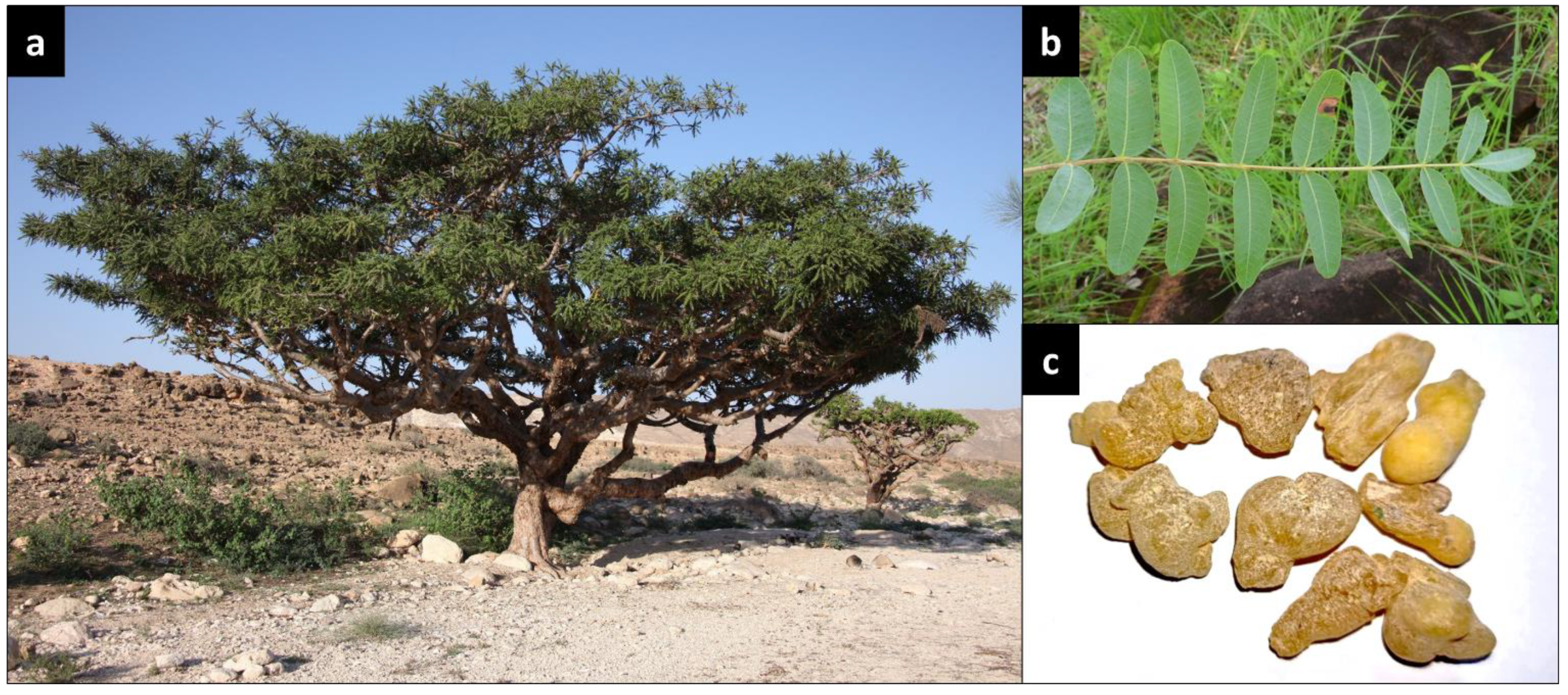
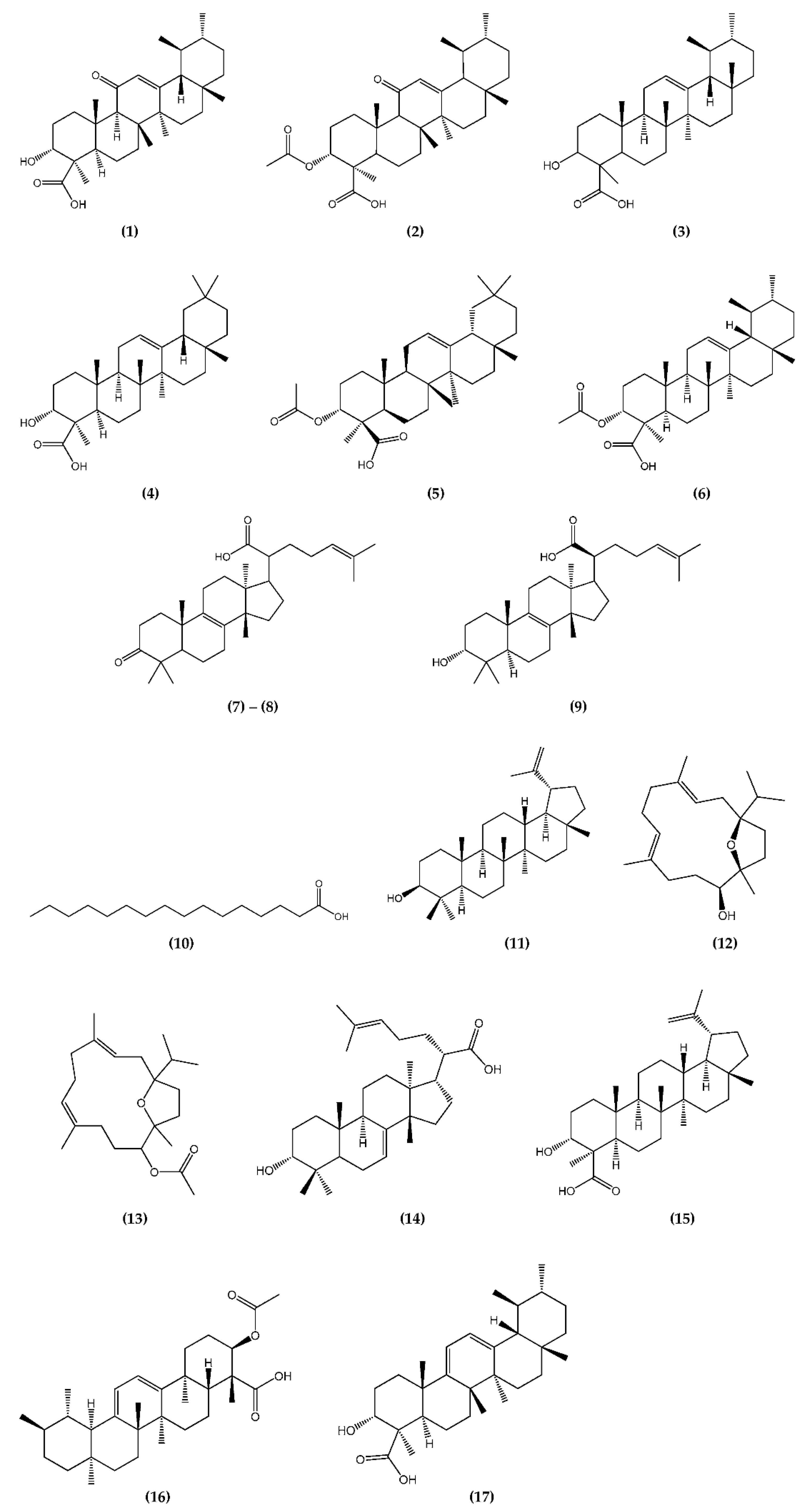
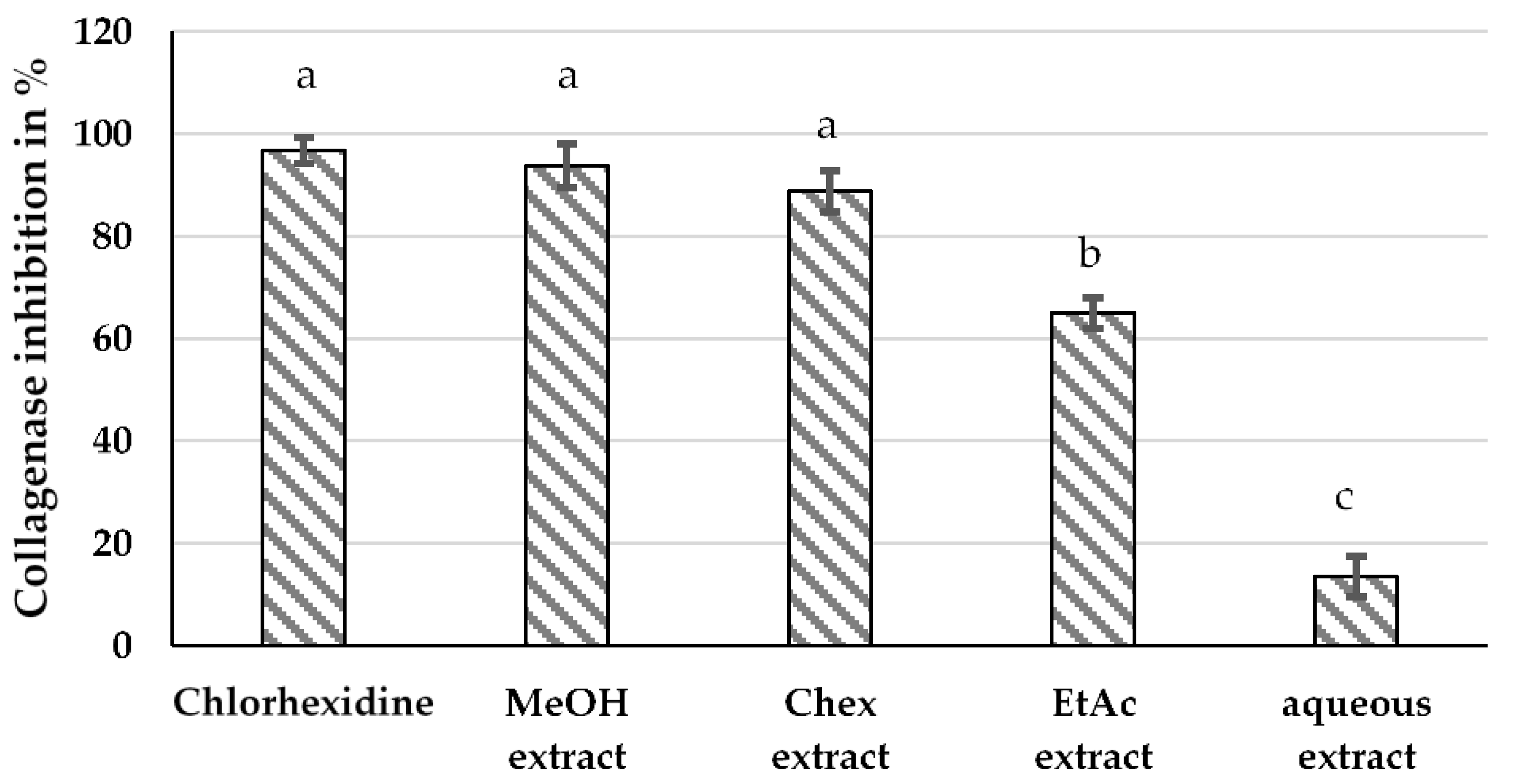
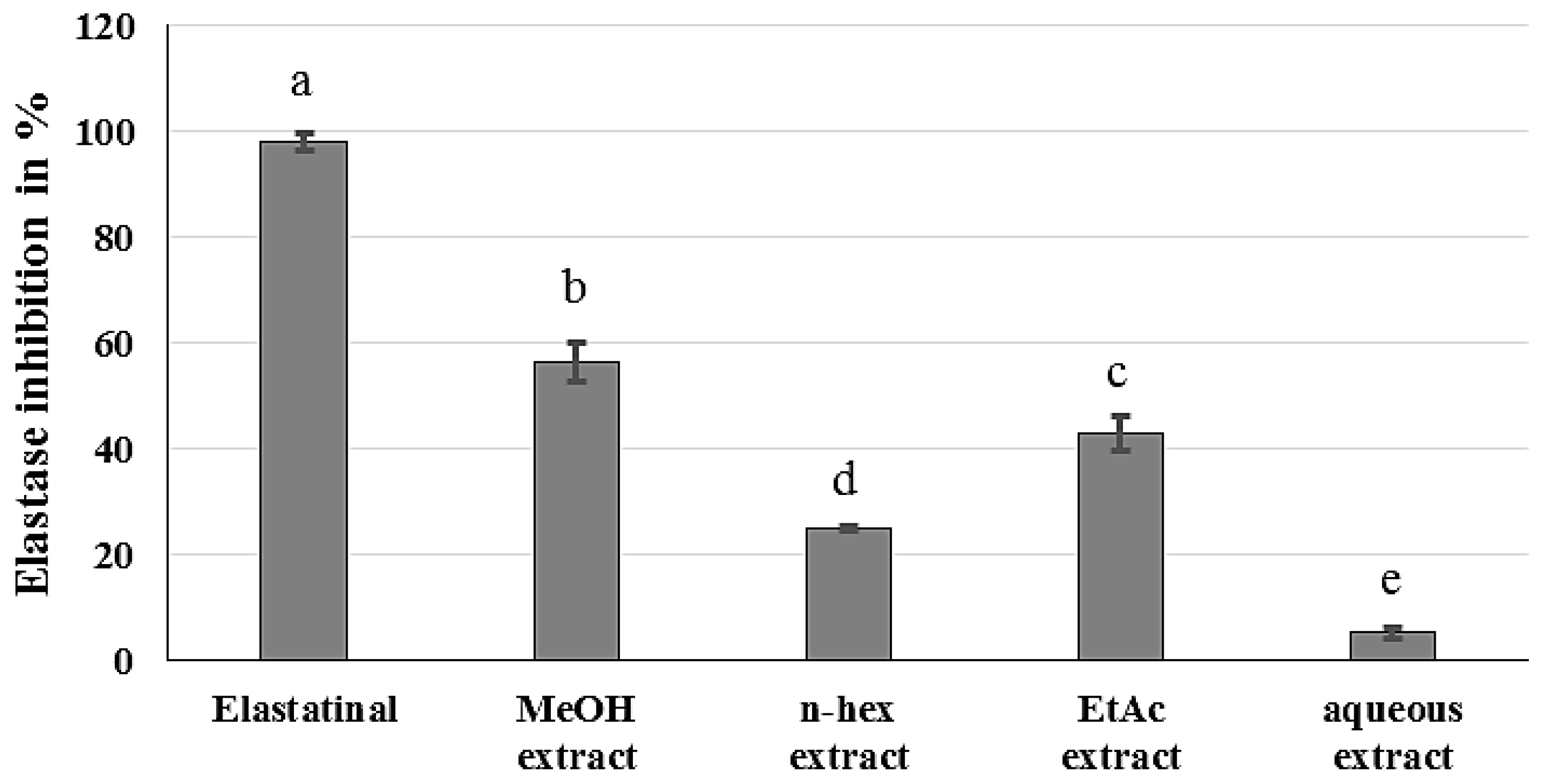

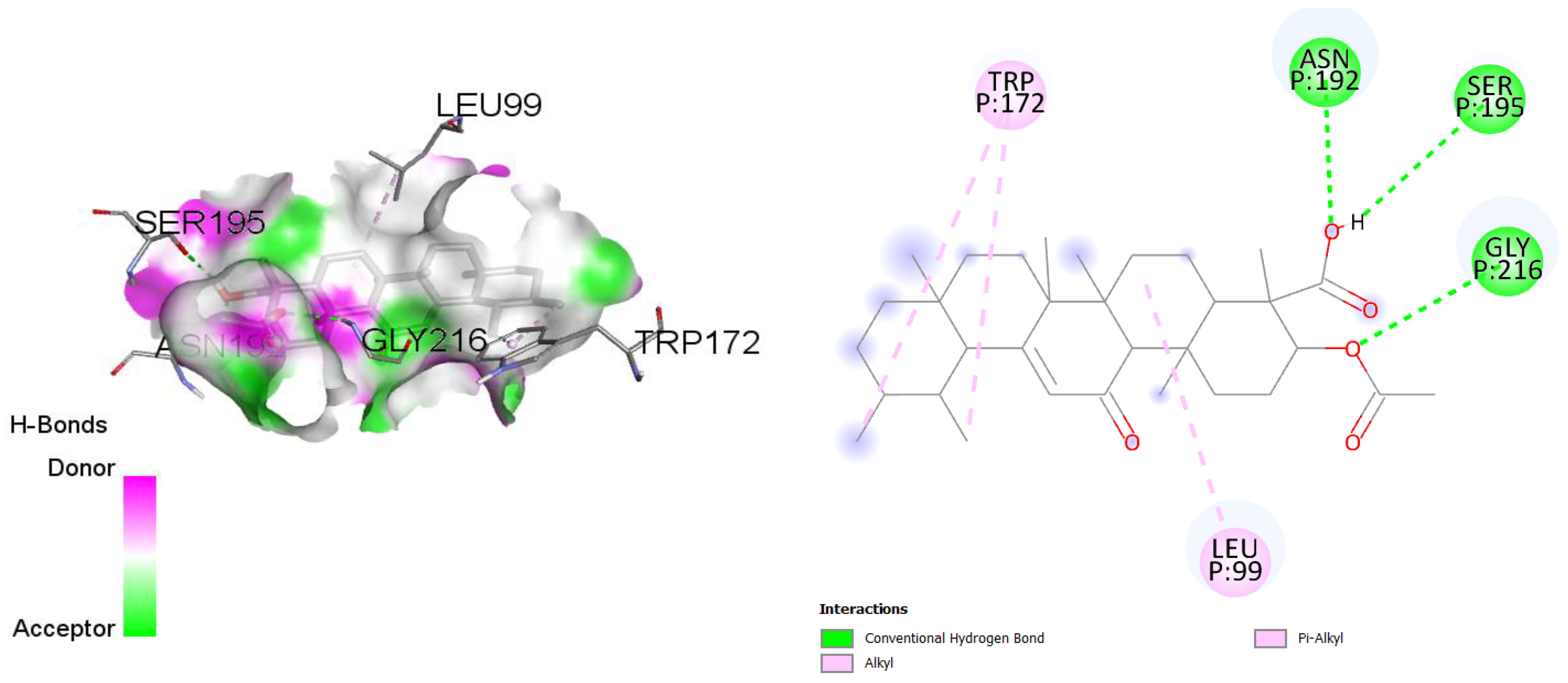
| N° | Compound | Pubchem (CID) | Score (Kcal/mol) | |
|---|---|---|---|---|
| Collagenase | Elastase | |||
| 1 | 11-keto-beta-boswellic acid | 6918114 | −9.5 | −5.6 |
| 2 | Acetyl 11-keto-beta-boswellic acid | 71463896 | −8.9 | −5.5 |
| 3 | Beta-boswellic acid | 168928 | −9.8 | −5.5 |
| 4 | Alpha-boswellic acid | 637234 | −10.4 | −5.2 |
| 5 | Acetyl-alpha-boswellic acid | 117072585 | −10 | −5 |
| 6 | Acetyl-beta-boswellic acid | 11386458 | −8.7 | −6.6 |
| 7 | 3-Oxotirucallic acid | 134693088 | −10.1 | −5.3 |
| 8 | Elemonic acid | 15559100 | −10.3 | −5.9 |
| 9 | 3-Beta-hydroxytirucallic acid | 441677 | −9.9 | −6.2 |
| 10 | Palmitic acid | 985 | −5.5 | −4.2 |
| 11 | Lupeol | 259846 | −10 | −5.7 |
| 12 | Incensole | 44583885 | −7.6 | −5.3 |
| 13 | Incensole acetate | 73755086 | −7.3 | −4.7 |
| 14 | 3-Alpha-hydroxytirucalla-7,24-dien-21-oic acid | 158143 | −10.2 | −6.4 |
| 15 | Lupeolic acid | 12111950 | −9.6 | −6.2 |
| 16 | Acetyl-9,11-dehydro-beta-boswellic acid | 44558899 | −10.6 | −5.3 |
| 17 | 9,11-Dehydro-beta-boswellic acid | 102509765 | −11 | −5.3 |
| N° | Compound | Collagenase | Elastase | ||
|---|---|---|---|---|---|
| Score (Kcal/mol) | Involved Amino Acids | Score (Kcal/mol) | Involved Amino Acids | ||
| 1 | 11-Keto-beta-boswellic acid | −9.6 | Asn180, His222, His228, Pro238 | −7.4 | His57, Leu99 |
| 2 | Acetyl 11-keto-beta-boswellic acid | −9.2 | Asn180, His222, His228, Pro238 | −8.2 | Leu99, Trp172, Asn192, Ser195, Gly216 |
| 3 | Beta-boswellic acid | −9.6 | Ala184, His228, Pro238 | −6.7 | Ser96, Leu99, Cys220 |
| 4 | Alpha-boswellic acid | −10.0 | Ala184, His228, Pro238 | −6.4 | His40, His57, Asn192 |
| 5 | Acetyl-alpha-boswellic acid | −9.6 | Leu181, Val215, His222, His228, Pro238 | −6.4 | His57, Gly216 |
| 6 | Acetyl-beta-boswellic acid | −8.5 | Leu181, His218, His222, His228, Pro238 | −7.9 | Leu99, Trp172, Ser195, Gly216 |
| 8 | Elemonic acid | −10.4 | Asn180, Leu181, Ala182, Val215, His218, His222, Pro238 | −7.4 | His57, Leu99, Asn192, Ser195, Val213, Cys220 |
| 10 | Palmitic acid | −5.6 | Leu181, His183, Arg214, Val215, His218, His228, Pro238 | −4.2 | Leu99, Phe215 |
| N° | Compound | Toxicity Risk a | Biodisponibility and Drug Score b | |||||||
|---|---|---|---|---|---|---|---|---|---|---|
| MUT | TUM | IRR | TER | PM | CLP | S | DL | DS | ||
| 1 | Beta-boswellic acid |  |  |  |  | 456.0 | 6.0 | −6.11 | −2.46 | 0.17 |
| 2 | Alpha-boswellic acid |  |  |  |  | 456.0 | 6.06 | −6.13 | −2.03 | 0.18 |
| 3 | Acetyl-beta-boswellic acid |  |  |  |  | 498.0 | 6.49 | −6.52 | −2.37 | 0.14 |
| 4 | Acetyl-alpha-boswellic acid |  |  |  |  | 498.0 | 6.55 | −6.54 | −1.92 | 0.15 |
| 5 | Acetyl 11-keto-beta-boswellic acid |  |  |  |  | 512.0 | 5.78 | −6.17 | −1.72 | 0.17 |
| 6 | 11-Keto-beta-boswellic acid |  |  |  |  | 470.0 | 5.29 | −5.76 | −1.77 | 0.21 |
| 8 | Palmitic acid |  |  |  |  | 256.0 | 6.06 | −4.24 | −25.22 | 0.09 |
| 10 | Elemonic acid |  |  |  |  | 454.0 | 7.29 | −5.98 | −5.21 | 0.09 |
Publisher’s Note: MDPI stays neutral with regard to jurisdictional claims in published maps and institutional affiliations. |
© 2022 by the authors. Licensee MDPI, Basel, Switzerland. This article is an open access article distributed under the terms and conditions of the Creative Commons Attribution (CC BY) license (https://creativecommons.org/licenses/by/4.0/).
Share and Cite
Hourfane, S.; Mechqoq, H.; Errajouani, F.; Rocha, J.M.; El Aouad, N. In Vitro and In Silico Evaluations of Boswellia carterii Resin Dermocosmetic Activities. Cosmetics 2022, 9, 131. https://doi.org/10.3390/cosmetics9060131
Hourfane S, Mechqoq H, Errajouani F, Rocha JM, El Aouad N. In Vitro and In Silico Evaluations of Boswellia carterii Resin Dermocosmetic Activities. Cosmetics. 2022; 9(6):131. https://doi.org/10.3390/cosmetics9060131
Chicago/Turabian StyleHourfane, Sohaib, Hicham Mechqoq, Fatima Errajouani, João Miguel Rocha, and Noureddine El Aouad. 2022. "In Vitro and In Silico Evaluations of Boswellia carterii Resin Dermocosmetic Activities" Cosmetics 9, no. 6: 131. https://doi.org/10.3390/cosmetics9060131
APA StyleHourfane, S., Mechqoq, H., Errajouani, F., Rocha, J. M., & El Aouad, N. (2022). In Vitro and In Silico Evaluations of Boswellia carterii Resin Dermocosmetic Activities. Cosmetics, 9(6), 131. https://doi.org/10.3390/cosmetics9060131










